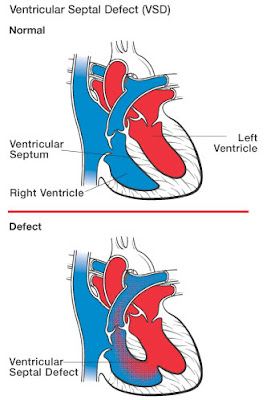The VSD

Ventricular Septal Defect (VSD) What It Is The septum is a wall that separates the heart's left and right sides. Septal defects are sometimes called a "hole" in the heart. A defect between the heart's two lower chambers (the ventricles) is called a ventricular septal defect (VSD). When there is a large opening between the ventricles, a large amount of oxygen-rich (red) blood from the heart's left side is forced through the defect into the right side. Then it's pumped back to the lungs, even though it's already been refreshed with oxygen. This is inefficient, because already-oxygenated blood displaces blood that needs oxygen. This means the heart, which must pump more blood, may enlarge from the added work. High blood pressure may occur in the lungs' blood vessels because more blood is there. Over time, this increased pulmonary hypertension may permanently damage the blood vessel walls. If the opening between the ventricles is small, it doesn...
